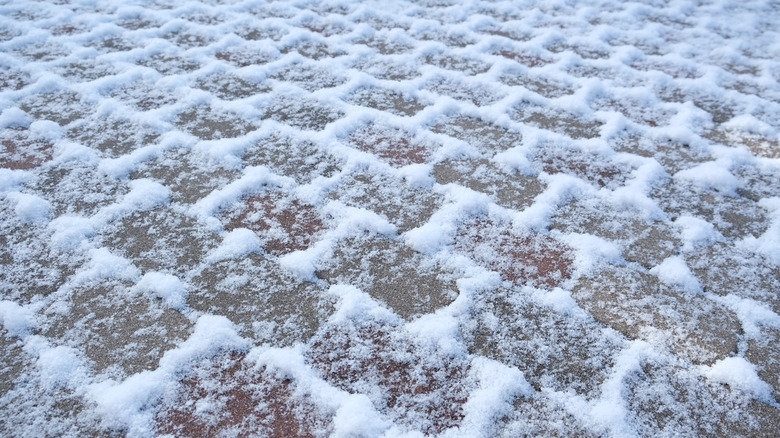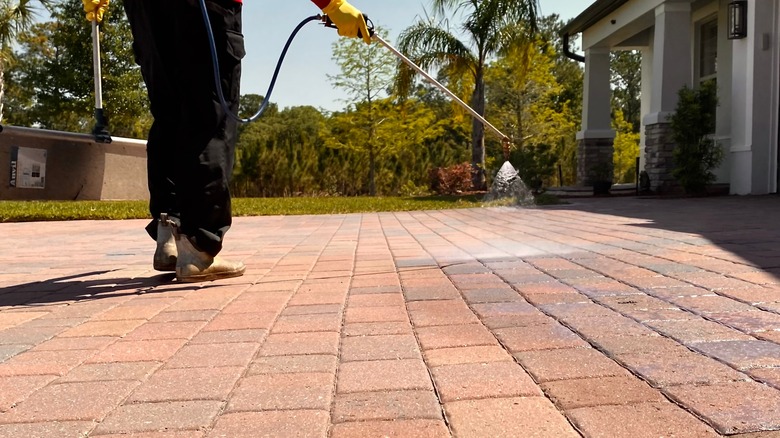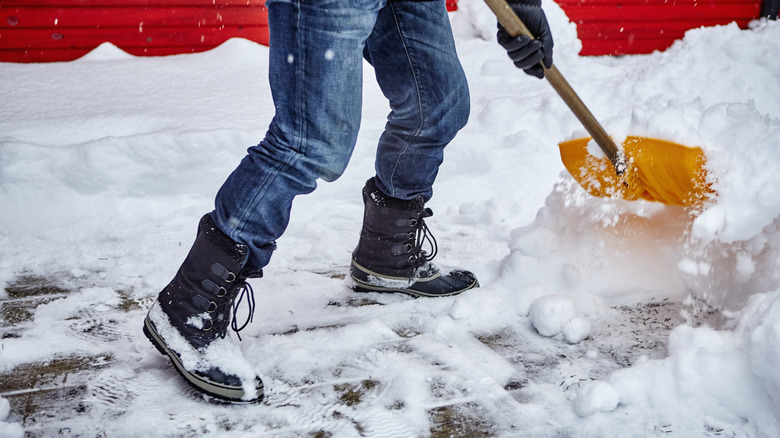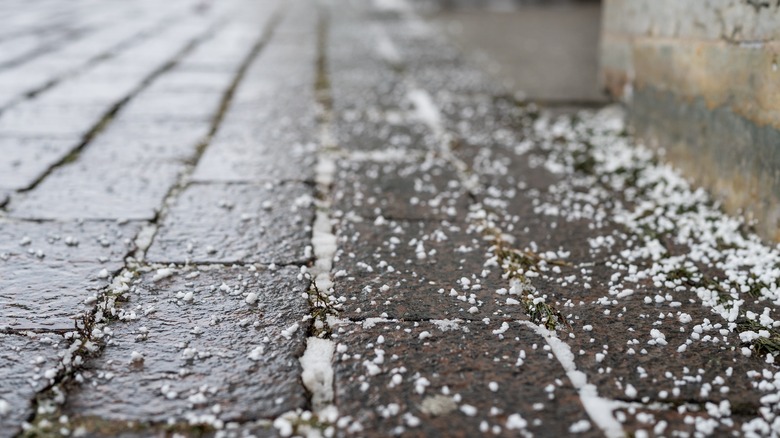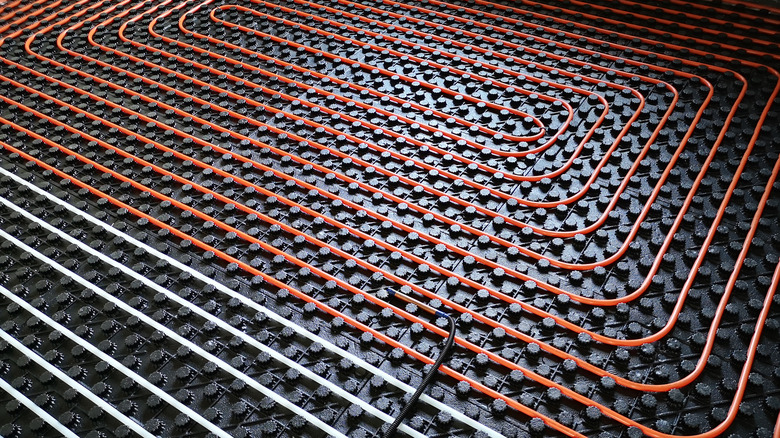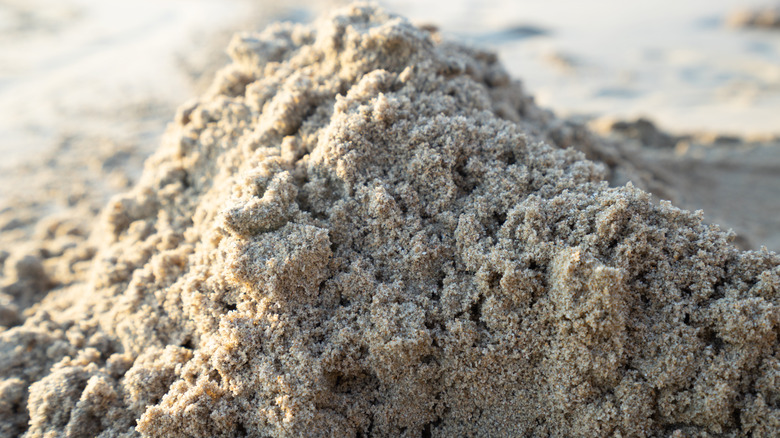Safely Get Rid Of Ice On Your Patio Pavers With These Tips And Tricks
We may receive a commission on purchases made from links.
Paver patios come with a number of advantages. They offer vast design options, last long, and don't require extensive maintenance. That said, like any other outdoor surface, a paver patio must be deiced in winter if you want to use it without risking a slip-and-fall accident. And unfortunately, pavers don't stand up well to traditional deicing methods, like salting or shoveling. When deicing salt melts a sheet of ice on top of pavers, the water-salt mixture penetrates the pavers, then expands and contracts multiple times as outdoor temperatures cycle to and from below freezing. These cycles cause the pavers to deteriorate. Metal shovels are equally damaging, as their edges can scuff or even crack the pavers.
Luckily, there are a few things you can do to minimize damage to the paver patio while effectively removing ice. For one, you can seal the pavers to keep ice from forming in their pores. Preventing ice formation through prompt snow clearing is another helpful practice. Meanwhile, deicing compounds such as calcium magnesium acetate, vinegar, and beet juice offer gentler alternatives to deicing salt, and snow-melt systems automate ice removal without endangering the pavers at all. Finally, there are safe ways to add traction to an icy paver patio if deicing isn't an option. We walk you through all these tips and tricks below.
Make sure the patio pavers are sealed
There are many arguments for and against sealing patio pavers, but one significant advantage sealants offer is that they prevent ice from building up in the pavers' pores and gaps. Patio pavers are naturally porous. When nearby snow melts and the resulting water flows over their surface, they will absorb some of the water. As the temperatures fall below freezing, this water embedded in the pavers' surface will turn into stubborn and damaging ice. As this ice thaws and freezes again and again, the ensuing expansion and contraction can do a great deal of damage to the patio pavers. Sealing your backyard patio pavers properly is a great way to avert these issues.
There are two types of sealants you can use on patio pavers. Water-based sealers are generally easier to apply and clean, and are less harmful to the surrounding environment (such as your garden plants or turf). These sealers do a great job of impregnating the paver surface, leaving less room for water to infiltrate and turn to ice. They also strengthen the sand in the paver gaps, which further prevents water and ice build-up. When you treat pavers with a water-based sealer, you end up with a matte look. For the purposes of minimizing ice damage and preventing its formation in the paver gaps, water-based sealers are the best choice. On the other hand, solvent-based are better at resisting oil and grease stains. They have far higher concentrations of volatile organic compounds, which makes them more harmful to the environment. Also, solvent-based sealers are a bit more difficult to apply and clean up after. These sealers give your patio a wet, glossy appearance.
Get rid of snow as soon as possible
You must do what you can to keep ice from forming on the pavers in the first place. By letting snow sit on your patio pavers for a long time, you're subjecting it to temperature swings and the ensuing freeze-thaw cycles. These cycles cause the snow to melt as the temperatures rise, then refreeze — now as ice — as the mercury dips. After some time, the cover of snow is sure to at least partially turn into ice and force you to take more drastic measures to clear the pavers. What's worse, if the snow melt water gets into gaps between the pavers and undergoes several freeze-thaw cycles there, it may move the pavers out of alignment. To deny ice an easy opportunity to form, make sure you clear the snow right after it falls.
However, removing snow from a paver surface requires care and special tools. Taking a metal snow shovel to the pavers is a bad idea, since the metal can scrape the stones easily. Likewise, a snow blower can also deface the pavers with its auger. To protect your pavers during snow removal, use a plastic or rubber shovel for the task. You can even try and sweep the snow away with a broom instead — especially if only a little bit is left, or stuck inside the paver gaps. Regardless of the equipment you're using, don't get too aggressive with stubborn patches of snow. You may want to save time when shoveling snow, but don't rush things, and keep your strokes gentle to make sure you don't scratch or chip the pavers inadvertently.
Use the right deicing agent
Traditionally used chemical deicing agents, such as sodium chloride, magnesium chloride, and calcium chloride are effective at removing ice from a paved surface (albeit at different temperatures). That said, these chemicals can ruin the pavers' surface due to their corrosive nature. Instead of subjecting your paver patio to a constant barrage of chemicals known to be corrosive, use an alternative deicing agent that's a bit gentler on the stones: Calcium Magnesium Acetate (CMA). This substance is far less corrosive, and inflicts less harm on the surfaces you apply it to. Unlike salt, which melts ice outright, CMA stops it from forming a bond with the pavers' surface. This property makes mechanical ice removal that much easier. Apart from these benefits, CMA is also biodegradable and requires fewer applications to melt ice effectively.
There are several other substances you can use in our quest to keep the patio pavers ice-free. Believe it or not, vinegar is another rock salt alternative. Vinegar's constituent acetic acid (which also gives CMA some of its powers) lowers water's freezing point, which raises the temperature at which ice melts. Likewise, beet juice is a natural product you can use to deice patio pavers because it also lowers the temperature at which ice remains frozen. You can use beet juice together with salt — the sugar from the roots' juice accelerates the ice melting process, so much less salt is needed to remove the ice quickly. The less salt you apply, the less damage your pavers sustain.
Use snow melting systems
Haven't installed your patio pavers yet and are thinking proactively about wintertime deicing? Good on you — equipping the patio pavers with snow-melting technology can prevent future headaches by making chemical and mechanical deicing largely unnecessary. Outdoor snow melt systems work much like radiant floor heating. Hydronic systems comprise water-carrying tubes that run beneath the surface of a patio or driveway and connect to a boiler. The boiler heats the water, while a circulating pump keeps it flowing through the network of tubes. The heat from the tubes rises and gets absorbed by the pavers, where it acts as an effective obstacle to ice or snow accumulation. Meanwhile, electric systems are made up of cables that heat up and melt the snow. Nowadays, snow-melt systems come equipped with sensors that enable them to switch on and off automatically — a feature that helps you conserve both effort and energy.
If your patio is already installed and you have no way of adding an underlying snow melt system, don't despair. You can place snow-melt mats, like this mat from HeatTrack, on top of the patio surface and use radiant heat to prevent ice build up, or melt an existing ice sheet. These mats come with an integral, electricity-powered heating element that generates warmth when switched on. Snow melt mats are far less efficient than the built-in radiant heat systems we described above, but they'll work if manual or chemical deicing isn't an option for you.
In a pinch, add traction to an icy patio with sand or cat litter
If the ice sheet on your patio is too tough to tackle, or any of the ice removal tips we listed above aren't viable in your circumstances, there's still something you can do to make an icy patio safe. If you've got a feline companion at home, you can borrow some of their kitty litter and sprinkle it onto the icy patio. The substance will not melt the ice, unfortunately, but it will add some traction to the ice and make the surface less slippery.
That said, it's important to use the right type of kitty litter for adding traction to an icy patio; otherwise, you risk exacerbating the problem. Only non-clumping kitty litter works. This type of litter is designed to absorb moisture, and it's perfectly safe to apply to an icy surface. On the other hand, clumping litter bonds together into clusters when exposed to moisture. When you throw it onto ice or snow, this type of litter eventually turns into mush and makes the surface even more slippery. Coarse sand is a traction-adding alternative to kitty litter, but if you use too much of it during winter, you risk overwhelming the surrounding topsoil with sand when snowmelt and rain eventually washes it off the patio come spring.
